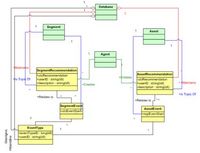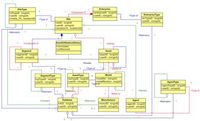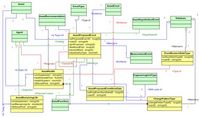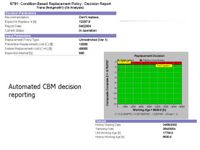omdec.com
http://www.omdec.com/moxie/Technical/Reliability/exakt-intelligent-agents-.shtmlEXAKT Intelligent Agents, Reliability, and MIMOSA
By Murray Wiseman
Optimal Maintenance Decisions Inc.
When ideas achieve currency, momentus change ensues. A unified approach to information sharing in operations and maintenance (O&M) has been gathering momentum, over the past decade. MIMOSA[1], the OPC Foundation[2], and the ISA[3] have launched OpenO&M, a comprehensive, open information architecture for unfettered technical collaboration in the modern O&M environment.
Compatible information exchange among diverse plant and business sub-systems encourages the use of “Agents” for effective analysis and decision making. Intelligent agents may, thus, access and combine data from many different sources, for example, process control systems, maintenance systems, and financial systems throughout the enterprise. Agents return decisions or recommendations that, by design, benefit the organization. For example, an EXAKT™ intelligent agent monitors the CBM (condition based maintenance) and the CMMS databases. Automatically, it generates and sends to the CMMS, optimal recommendations on when and how to perform a maintainance intervention on an asset. Figure 1 is a MIMOSA UML[4] class diagram that shows the role of an intelligent agent[5].
Figure 1: MIMOSA UML Class diagram “EventCore”
Each of the boxes in the UML class diagram (Figure 1) represents a class[6]. Lines joining the classes represent relationships. The relationships of Figure 1 are called associations[7]. The red line, with the diamond head “”, joining the AssetRecommendation and Database entities, is an aggregation[8] (a “whole/part” association.)[9] The cardinality (“1” and “*” on the ends) indicates that the relationship is one-to-many. One database maintains many AssetRecommendation records.
MIMOSA has published a series of 15 such class diagrams. By studying these diagrams we may understand the utility of and the reasoning behind the MIMOSA Common Relational Information Schema (CRIS).
The MIMOSA classes, Segment and Asset (of Figure 1), require explanation. A segment is a production process or subprocess or physical area[10] on a site. An asset is an equipement (with a unique serial number) that can be allocated to a segment.
The association joining Segment and Site in Figure 2 has a solid diamond head “”. The solid diamond indicates that a Segment belongs uniquely to a Site[11]. On the other hand, an Asset (with an unfilled diamond head association “”) is only loosely associated with a site. For example, an equipment can, in principle, be moved to another Site.
Futhermore, an asset can be removed from one segment and installed on another. The association line joining Segment and Asset in Figure 2 reveals that relationship. Examine that association line. Note, the AssetUtilizationHistory class connected by a dashed line to the association line. The AssetUtilizationHistory class is called an association class. It provides further clarity on the nature of that association. In this relationship the objects (database records) of the AssetUtilizationHistory class, record the removals and the installations of assets on segments. These records provide the suspension and Failure “Events” for an EXAKT CBM optimization model[12].
Figure 3 shows three more associations between the Agent and other MIMOSA classes. The Agent has the role of “Originator” of AssetRemainingLife records and AssetHealth records. It also “Creates” AssetProposedEvent records. Consistent with RCM functional and failure analysis, the AssetProposedEvent has a “Proposed impact” on AssetFunction.
We may conclude from the various MIMOSA UML class diagrams, that the MIMOSA and OPC OpenO&M architecture recognizes the vital role of intelligent agents in maintenance decision planning.
An EXAKT agent outputs the data required to populate the MIMOSA Common Relational Information Schema (CRIS) tables AssetRecommendation, AssetProposedEvent,AssetHealth, and AssetRemainingLife.
The agent uses a statistical “data interpretation” model that has been built by correlating historical event and condition monitoring data. The model accounts for the current operating context of an asset. Finally, the model supports the user’s requirements regarding that asset for which the enterprise defines its objectives, for example:
- failure and repair cost minimization,
- asset availabiltity maximization,
- a required mean time between repairs,
- a required ratio of planned to emergency work, or some combination of these or other metrics.
By consistently adhering to the optimal recommendations delivered by the EXAKT intelligent agent, an organization will achieve its stated long-run objectives for each asset monitored.
Do you have any comments on this article? If so send them to murray@omdec.com.
[1] www.mimosa.org
[2] OPC Foundation (www.opcfoundation.org)
[3] The Instrumentation, Systems, and Automation Society (www.isa.org)
[4] The UML is the Unified Modeling Language. See “The Unified Modeling Language User Guide” by Grady Booch, James Rumbaugh, Ivar Jacobson, Addison-Wesley 1999, ISBN 0201571684
[5] An intelligent agent is an automated entity that processes data and makes decisions and recommendations. The MIMOSA Agent class may also include humans and organizations who fulfill the same role.
[6] A class is a specification for an object. An object can represent some physical item used in the business process – for example a work order record in a database table of work orders.
[7] An association is one of the four types of relationships: 1. Dependency, 2. Association, 3. Generalization, and 4. Realization
[8] A structural relationship such as a table belonging to a database or a printed circuit belonging to a electronic device.
[9] This means that an object of the whole has objects of the part.
[10] For example “Compressor Room 1”
[11] For example “Compressor Room 1” is strongly related to a Site.
[12] Or any type of reliability (age exploration) analysis: Weibull, Pareto, Scatter, Cause and Effect, and others.



